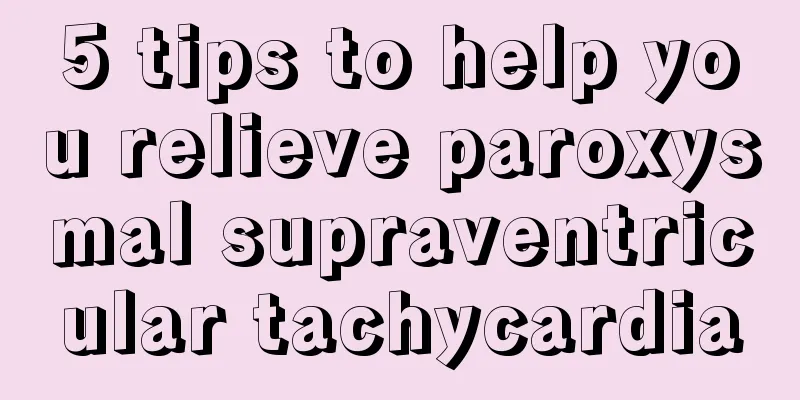5 tips to help you relieve paroxysmal supraventricular tachycardia

|
Paroxysmal supraventricular tachycardia often occurs very suddenly. People often feel dizzy and chest tightness while they are still talking and laughing at work, and may even suddenly faint and lose consciousness. Often at this time people are particularly panicked and scared, and don't know what to do. Experts say that when paroxysmal supraventricular tachycardia occurs, everyone must not be nervous, the more nervous you are, the more serious the condition will become. You may want to try the following methods to relieve your symptoms. 1. Breath holding method Ask the patient to take a deep breath and hold it until he or she can no longer hold the breath, then exhale forcefully. 2. Throat stimulation Stimulating the throat with your fingers or a tongue depressor to induce nausea and vomiting can help terminate the attack. 3. Eyeball compression Close your eyes and look down, use your fingers to press the upper part of the eyeball under the eye socket, starting with the right eye. At the same time, take your pulse and count your heart rate. Once the tachycardia stops, stop the compression immediately and do not use excessive force. Do this for 15 seconds each time. If pressing on one side is ineffective, switch to the other side. Avoid pressing on both sides at the same time. At the same time, take propranolol or propranolol tablets orally. Note: This method is contraindicated for patients with glaucoma or severe myopia. 4. Carotid sinus compression The patient lies supine, and family members help compress the carotid sinus on one side (at the level of the thyroid cartilage, with the carotid pulsation pressed toward the cervical vertebrae) for 10 to 20 seconds each time. If this is ineffective, switch to the other side. When applying pressure, the movements should be gentle and not too strong. At the same time, the pulse should be felt to monitor the heart rate. If you find that the heart rate suddenly becomes regular and normal, you should stop the compression immediately. Do not compress both sides at the same time to avoid causing obvious cerebral ischemia. Note: This method is contraindicated for patients with a history of carotid artery allergy or cerebrovascular disease. 5. Diving Reflex It can strongly excite the vagus nerve and is more effective for young infants. The method is to soak a towel or ice water bag with ice water at about 5°C and apply it to the entire face for 10 to 15 seconds each time. If it doesn't work once, try again every 3 to 5 minutes. Adults can sit down and place a basin of cold water below 5℃ on the table in front of them. Ask the patient to take a deep breath and hold the breath, and immediately immerse the face in the cold water for about 30 seconds. If it doesn't work, you can repeat this method after resting for a few minutes. This method is often effective for adults with difficult-to-control paroxysmal supraventricular tachycardia. |
<<: How to treat trypophobia? Six tips to help you easily overcome
Recommend
What should I do if I get scalded by boiling water?
Being scalded by boiling water is a very common a...
What to do if gums shrink and tooth roots are exposed? Guide to quick recovery
The phenomenon of gingival recession (gingival re...
What are the acupuncture points for abdominal weight loss
Now that living standards are gradually improving...
What are the symptoms of advanced gastric cancer
What are the symptoms of mid-to-late stage gastri...
How to remove the formaldehyde smell from new clothes?
People always don't pay much attention to the...
Causes of poor blood circulation
I believe everyone knows the importance of blood....
How long can you live with benign pancreatic cancer
In life, people think that pancreatic cancer is a...
What are the imported anticancer drugs for colon cancer
The level of medical care is now more advanced th...
What is the correct way to shrink nose pores?
Many people now find that because the nose secret...
Revealed: Common causes of cervical cancer
Cervical cancer is a common malignant tumor among...
Will I definitely not have my period if I'm pregnant?
We all know that a woman's body will undergo ...
Symptoms of esophageal cancer at different stages
For patients at different stages of esophageal ca...
I feel like there are bugs crawling on my body
Sometimes I always feel like there are bugs crawl...
How long does it take for acupuncture breast augmentation to be effective?
Nowadays, there are many ways to enlarge breasts....
Clostridium botulinum food poisoning
In life, we only know that food can be poisonous ...









